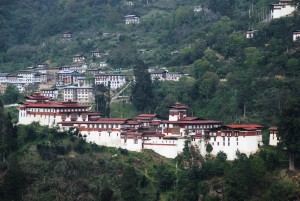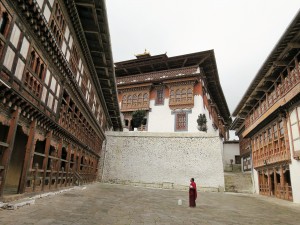
If you ever do visit Bhutan, make it a point to travel to Trongsa. I’ll tell you why but, first, let’s delve into the region called the vanguard of the warriors a bit.
The town of Trongsa in central Bhutan is also the capital of the district that goes by the same name. The name Trongsa in Dzongkha translates to ‘new village’ and that’s a little odd because the town and the region is significantly old (the first temple there was built in 1543 by Ngagi Wangchuck who was the great-grandfather of Zhabdrung Ngawang Namgyal – the unifier of Bhutan).
But, despite the argument about how new or old the region is, you should visit simply because Trongsa is rich in history, it has the most spectacularly sited dzong in Bhutan, and the first two Kings of the Wangchuck dynasty ruled the Kingdom from there.
Tradition still dictates, even today, that the Crown Prince serve as Trongsa Penlop (governor) before acceding to the throne.
Anyway, I made my way to Trongsa after being part of the colorful Tshechu (festival) in Wangdue. The town of Trongsa is bang in the middle of Bhutan and needless to say very beautiful and tantalizing. Even though the distance between the two towns is only 123km, the journey took me approximately seven hours. Perhaps that is because of the winding road that one has to navigate with skill and precision.

The scenery along the route is magnificent as it traverses through the mighty Black Mountain and through Pelela (high mountain pass) decorated with a stupa and prayer flags of every shape and hue. The air is sweet and the stop there is truly refreshing in that it rejuvenates your senses in every which way possible. And as you enter Trongsa, the first sight that catches you is that of the huge dzong.
The spectacular dzong, with a sheer drop to its south that often disappears into cloud and mist, is built on a mountain spur above the gorges of the Mangde Chhu. I learnt that back in the day, the commanding dzong controlled the east-west trade for centuries.
Once inside, the sprawling assemblage of structures that comprise the dzong trails down the ridge and is connected by a succession of alley-like corridors, wide stone stairs and beautiful paved courtyards. The southernmost part of the dzong, Chorten Lhakhang, is the location of the first hermitage and it was the one built in 1543.
My guide Sonam from Little Bhutan told me that the dzong was built in its present form in 1644 by Chhogyel Mingyur Tenpa, the official who was sent by the Zhabdrung to bring eastern Bhutan under central control. I must say that Sonam was very knowledgeable and didn’t disappoint me one bit. He told me that the route between eastern and western Bhutan leads straight through Trongsa and straight through the dzong itself. This strategic placing, I could figure, gave the rulers immense control over the east-west trade. Legend has it that at the command of the Penlop the massive doors could be shut, dividing the country in two.
Nevertheless, while most visitors today enter the dzong through the main eastern gate, I was adventurous enough as Sonam was ever obliging to allow me to make the steep hike along the Mangdue Foot Trail from the viewpoint. Thus, I entered the magnificent fortress via the western gate like it was done for centuries earlier.
The Trongsa monk body migrates between winter and summer residences of Trongsa and Bumthang respectively, just as the main dratshang or the central monk body does between Thimphu and Punakha. There are 23 separate lhakhangs in the dzong and most of the existing fine decoration, Sonam enlightened me, was designed during the rule of the first king, Sir Ugyen Wangchuck. If I remember correctly, the first king was given the title of Sir by the British.
Inside the dzong, the rooms to visit include the atmospheric northern assembly hall and the southern Mithrub Lhakhang that houses the funerary chorten of the founder, Ngagi Wangchuck.
Sadly, I wasn’t there during the time of the Tshechu, which I believe is held in the northern corridor sometimes in December or January and culminates in the unveiling of a large tongdrol (a very big thangka). But, at least I got to visit the pavilion where the current king His Majesty Jigme Khesar Namgyel Wangchuck was crowned penlop in 2004, when he was the Crown Prince.
In the end, of all the places I visited in Bhutan, I was captivated by Trongsa the most. Not only was its setting beautiful but its legends and myths were equally fascinating, and its small charming town and people indeed magnanimous. It was definitely worth the long, long drive.

